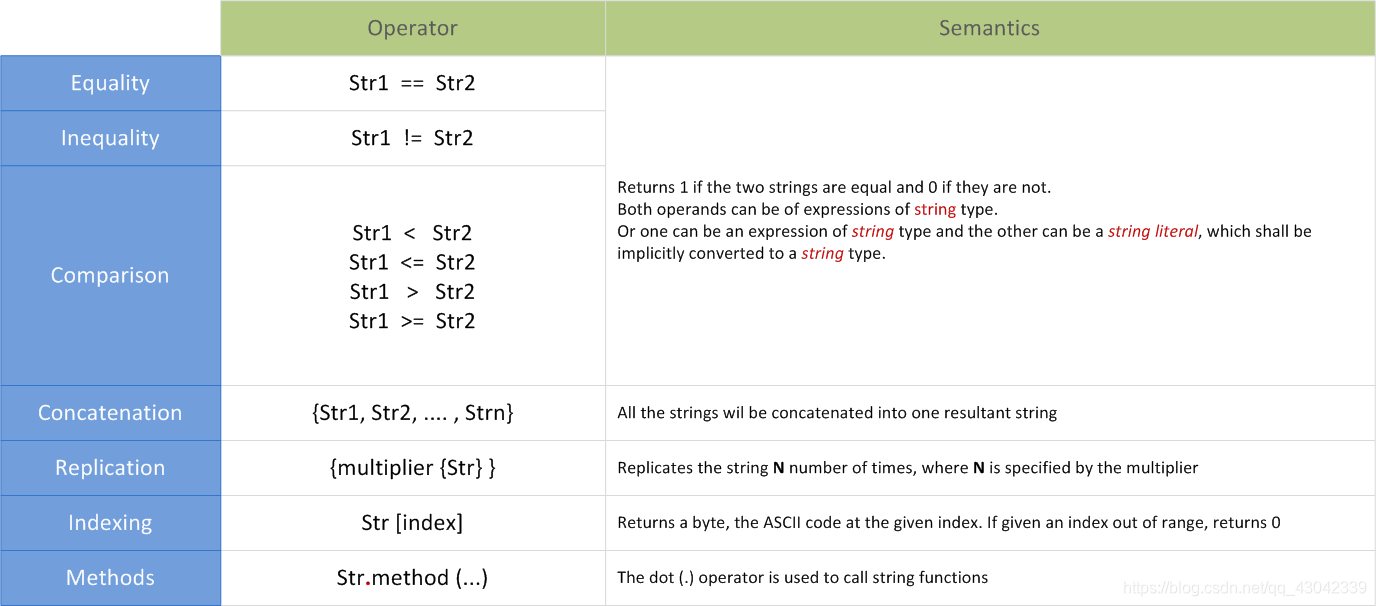什么是SystemVerilog字符串?
字符串数据类型是字符的有序集合。 字符串变量的长度是集合中字符的数量,这些字符可以具有动态长度,并且在仿真过程中会有所变化。 字符串变量不能以与字符串文字相同的方式表示字符串。 使用字符串变量时,不会发生截断。
Syntax(句法规则)
string variable_name [= initial_value];
variable_name是有效的标识符,可选的initial_value可以是字符串文字,空字符串的值“”或字符串数据类型表达式。 如果在声明时未指定初始值,则变量默认为“”,这是一个空字符串文字。
SystemVerilog String Example
module tb;
// 声明一个名为“ dialog”的字符串变量以存储字符串文字
// 将变量初始化为“Hello”
string dialog = "Hello!";
initial begin
// 使用%s字符串格式显示字符串
$display ("%s", dialog);
// 遍历字符串变量以识别各个字符并打印
foreach (dialog[i]) begin
$display ("%s", dialog[i]);
end
end
endmodule
Simulation Log
ncsim> run
Hello!
H
e
l
l
o
!
ncsim: *W,RNQUIE: Simulation is complete.
Verilog中的字符串如何表示?
单个ASCII字符需要8位(1个字节),要存储一个字符串,我们需要的字节数与该字符串中的字符数一样多。
reg [16*8-1:0] my_string; // 可存储16个字符
my_string = "How are you"; //从MSB填充5个零,并存储11个字符
my_string = "How are you doing?" //19个字符; my_string将显示为“are you doing? "
String Operators

Example
module tb;
string firstname = "Joey";
string lastname = "Tribbiani";
initial begin
// String Equality : 检查 firstname是否等于lastname
if (firstname == lastname)
$display ("firstname=%s is EQUAL to lastname=%s", firstname, lastname);
if (firstname != lastname)
$display ("firstname=%s is NOT EQUAL to lastname=%s", firstname, lastname);
// String comparison :检查firstname 的长度<或>lastname的长度
if (firstname < lastname)
$display ("firstname=%s is LESS THAN lastname=%s", firstname, lastname);
if (firstname > lastname)
$display ("firstname=%s is GREATER THAN lastname=%s", firstname, lastname);
// String concatenation : 将firstname 和lastname连接成一个字符串
$display ("Full Name = %s", {firstname, " ", lastname});
// String Replication(字符串复制)
$display ("%s", {3{firstname}});
// String Indexing : 获取firstname和lastname的索引号2处的ASCII字符
$display ("firstname[2]=%s lastname[2]=%s", firstname[2], lastname[2]);
end
endmodule
Simulation Log
ncsim> run
firstname=Joey is NOT EQUAL to lastname=Tribbiani
firstname=Joey is LESS THAN lastname=Tribbiani
Full Name = Joey Tribbiani
JoeyJoeyJoey
firstname[2]=e lastname[2]=i
ncsim: *W,RNQUIE: Simulation is complete.
Basic String Methods(基本的字符串方法)
SystemVerilog还包括许多使用字符串的特殊方法,这些方法使用内置的方法表示法。

| Usage 用法 | Definition定义 | Comments注释 |
|---|---|---|
| str.len() | function int len() | 返回字符串中的字符数 |
| str.putc() | function void putc (int i, byte c) | 用给定字符替换字符串中的第i个字符 |
| – | – | |
| str.getc() | function byte getc (int i) | 返回str中第i个字符的ASCII码 |
| str.tolower() | function string tolower() | 返回字符串,其中str中的字符转换为小写 |
| – | – | |
| str.compare(s) | function int compare (string s) | 比较str和s |
| str.icompare(s) | function int icompare (string s) | 比较str和s,例如ANSI C strcmp函数 |
| – | – | |
| str.substr (i, j) | function string substr (int i, int j) | 返回一个新字符串,它是由str的位置i到j的字符组成的子字符串 |
Example
module tb;
string str = "Hello World!";
initial begin
string tmp;//字符串变量tmp
// 打印字符串“ str”的长度
$display ("str.len() = %0d", str.len());
// 分配给tmp变量并将char“ d”放在索引3
tmp = str;
tmp.putc (3,"d");
$display ("str.putc(3, d) = %s", tmp);
// 获取索引2处的字符
$display ("str.getc(2) = %s (%0d)", str.getc(2), str.getc(2));
// 将所有字符转换为小写
$display ("str.tolower() = %s", str.tolower());
tmp = "Hello World!";
$display ("[tmp,str are same] str.compare(tmp) = %0d", str.compare(tmp));
tmp = "How are you ?";
$display ("[tmp,str are diff] str.compare(tmp) = %0d", str.compare(tmp));
// 忽略大小写比较
tmp = "hello world!";
$display ("[tmp is in lowercase] str.compare(tmp) = %0d", str.compare(tmp));
tmp = "Hello World!";
$display ("[tmp,str are same] str.compare(tmp) = %0d", str.compare(tmp));
//从i提取到j 提取到新字符串
$display ("str.substr(4,8) = %s", str.substr (4,8));
end
endmodule
参考文献:
【1】https://www.chipverify.com/systemverilog/systemverilog-strings
